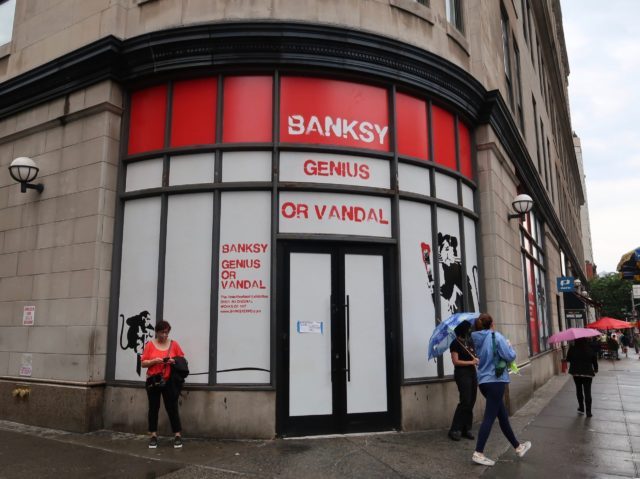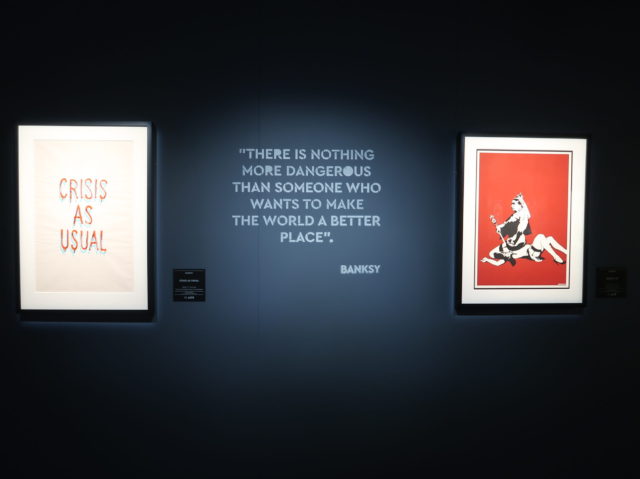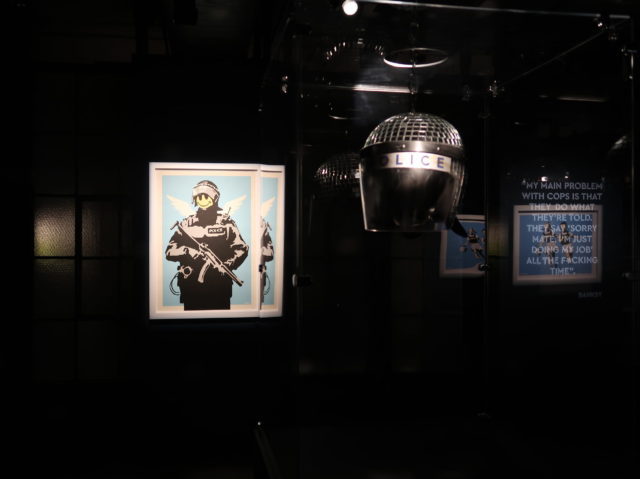
Unauthorized “Banksy: Genius or Vandal?” exhibit is selling out fast (photo by twi-ny/mdr)
BANKSY: GENIUS OR VANDAL?
526 Sixth Ave. at West Fourteenth St.
Wednesday – Monday through November 28, children $19.90, adults $29.50 ($5 additional for VIP)
banksyexpo.com
online slideshow
“There’s no such thing as good publicity,” Banksy wrote on a wall in a lot on West Broadway and McDougal in October 2008, accompanied by an image of a giant rat whitewashing over an ad for a Fox television show. The mysterious British artist and activist was in New York City for the opening of his free, immersive exhibition “The Village Pet Store and Charcoal Grill,” consisting of animatronic animals that were not available as either pets or meat.
There has not been a lot of good publicity for “Banksy: Genius or Vandal?,” an unauthorized exhibition of screenprints, photographs, and only a handful of original works by Banksy, one of three such traveling shows. (The others are “The Art of Banksy: ‘Without Limits’” and “The Art of Banksy: Unauthorized Private Collection.”) When told about the Moscow edition of one of the exhibits, he posted online, “What the hell is that? I wish I could find it funny. What’s the opposite of LOL? You know it’s got nothing to do with me, right? I don’t charge people to see my art unless there’s a fairground wheel.” When asked what he was going to do about it, he slyly replied, “Hmm — not sure I’m the best person to complain about people putting up pictures without permission.” Meanwhile, the Seoul edition of “Without Limits” offered visitors refunds once it became known that most of the works in the show were reproductions.
Among the replicas at the New York show is a reproduction of Banksy’s studio, based on the 2010 documentary Exit Through the Gift Shop. Since we still don’t know who Banksy is, the exhibition has to go to extreme lengths to come up with some form of biography.
The fairground wheel the Bristol-born Banksy was referring to was one of the attractions in his massive 2015 “Dismaland Bemusement Park,” a dark reimagination of Disneyland on the Somerset seaside for which he charged a mere three pounds for entry. “Banksy: Genius or Vandal?” includes a trailer for the park and a series of photographs. (Many of the items on view have been lent by Steve Lazarides, who worked with Banksy for more than a decade.) Of course, it’s not the same as being there, which is the essential problem when staging a show of site-specific street art in a gallery, in this case a large two-floor space on the corner of West Fourteenth St. and Sixth Ave. — and charging $19.90 for children and $29.50 for adults. “Genius or Vandal?” falls somewhere in between “Beyond the Streets,” which comprised works by graffiti artists hung on walls and standing on plinths, and the two immersive van Gogh experiences, which turned Vincent’s life and paintings into an Instagram-friendly fiasco.
Divided into thematic sections, “Genius or Vandal?” explores some of Banksy’s most famous pieces, which take on consumerism, police brutality, government surveillance, the health-care system, immigration, the royals, art history, and the art market. Among the images on display are Banksquiat, a rebuke of a Jean-Michel Basquiat exhibit about which Banksy wrote, “Major new Basquiat show opens at the Barbican — a place that is normally very keen to clean any graffiti from its walls”; Golf Sale, an image of a man holding up a “Golf Sale” sign in front of three tanks, referencing the individual famously refusing to move as tanks made their way through Tiananmen Square; Napalm, which brings together Mickey Mouse and Ronald McDonald holding hands with “Napalm Girl” Phan Thi Kim Phuc in the center; several of Banksy’s rats, declaring, “Get Out While You Can,” “If Graffiti Changed Anything It Would Be Illegal,” and “Welcome to Hell!”; and Pulp Fiction, in which the John Travolta and Samuel L. Jackson characters from the Quentin Tarantino film hold bananas instead of guns.
I have to admit that even with all my misgivings with the exhibit, I enjoyed seeing such originals as Welcome, a welcome mat made out of material from life jackets; Smiley Copper, a panel showing a heavily armed police officer with a yellow smiley face; and Grappling Hook, Banksy’s unique version of the crucifixion.

Exhibit features the words and images of mysterious British street artist and activist Banksy (photo by twi-ny/mdr)
There is also video of Girl with a Balloon shredding itself after being auctioned off for more than one million dollars in 2018 (which is widely available online); the resulting work, retitled Love Is in the Bin, is expected to be sold for more than five million at an October auction. For an additional five bucks, you can take a ten-minute virtual reality tour through suburban British streets, where numerous Banksy works suddenly appear as you fight off nausea. In an enclosed room, dozens of images are projected onto four walls, immersing you in Banksy’s oeuvre. And you can record yourself on live CCTV; Banksy might have been pointing out the fascist nature of video surveillance, asking, “What are you looking at?,” but now you can add footage of yourself directly to social media.
The mostly inane wall text and audioguide do the exhibition no favors. In discussing the 2011 Los Angeles wall piece Fire Starter, in which Charlie Brown is an arsonist, cigarette dangling from his mouth, the text defines the round-faced boy as “the protagonist of the animated film A Boy Named Charlie Brown.” Delving into Banksy’s fascination with primates, as in Monkey Parliament, Monkey Queen, and Laugh Now (in which a monkey wears overalls that proclaim, “Laugh now but one day we’ll be in charge”), the text notes that “the imagery is also well documented in cinematography. . . . [An] iconic film is Planet of the Apes by Tim Burton. This film tells us about a world in which monkeys have evolved so much so that they have enslaved humans.” And in discussing No Ball Games, in which two children are playing with a red sign that says “No Ball Games,” the text criticizes a previous unauthorized exhibition by pointing out, “Banksy had nothing to do with this company, nor with the exhibition that was held. Those are the ones who should be considered real vandals!”

Police brutality is one of several Banksy themes explored in exhibit (photo by twi-ny/mdr)
In many ways, all you need to know about the exhibition — which is unlikely to attract anyone who believes Banksy is in fact a vandal, making the title somewhat moot — is at the beginning and end. The show opens with a replica of Pasquino, a fifteenth-century Roman “talking statue” that was a precursor to political street art; it bears no relationship to Banksy or his work. And, in an ironic twist, you cannot exit through the gift shop, because there is none. Since “Banksy: Genius or Vandal?” is unauthorized, the creators don’t have any legal rights to the images they could otherwise plaster on hats, T-shirts, coffee mugs, etc., although you do get a poster with VIP admission.
Nonetheless, the narration does seem to be obsessed with Banksy’s “GrossDomesticProduct” temporary installation and online store, where you can purchase reproductions of some of the items in the New York show but includes the following warning: “The artist would like to make it clear that he continues to encourage the copying, borrowing, and uncredited use of his imagery for amusement, activism, and education purposes. Feel free to make merch for your own personal entertainment and nonprofit activism for good causes. However, selling reproductions, creating your own line of merchandise, and fraudulently misrepresenting knock-off Banksy products as ‘official’ is illegal, obviously a bit wrong, and may result in legal action. In the event of prosecution all funds will be donated to charity.”